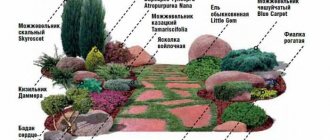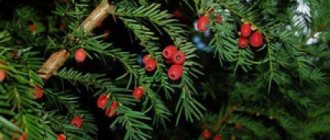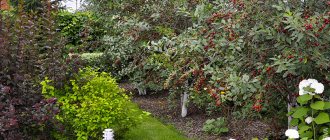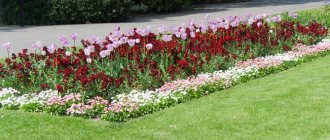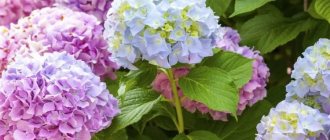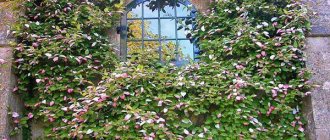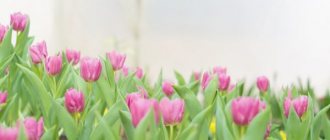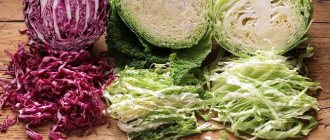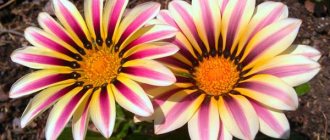In the Moscow region you can plant and grow many beautiful flowering shrubs. But it is important to choose those that can withstand low temperatures so that they can grow in the garden for many years. The publication lists exotic, evergreen, perennial, variegated and other species.
Among them you can choose bushes for any landscape design. They are planted one by one or in groups, creating unusual compositions and combinations. Ornamental shrubs for the Moscow region are shown in the photo with descriptions and signed names.
Blooming in the summer months
Below are garden ornamental shrubs that bloom throughout the summer.
Buddleia
Buddleias are fall-blooming shrubs that remain tolerant of low temperatures.
They are heat-loving, but if you properly hill up, insulate the root system, and cover them with spruce branches, you can prepare them for wintering in the Moscow region.
Hydrangea
Tree hydrangea is an easy-to-care, frost-resistant bush.
Another common variety is Annabelle.
Rhododendron
There are several varieties of rhododendron.
For central Russia, deciduous forms are best suited.
Here are the more winter-hardy ones:
- Lemon Lights;
- "Mandarin Lights".
It is recommended to choose hybrids from evergreen rhododendrons.
For example, “Mikkei” (Finnish selection), which is best suited for cultivation in central Russia.
Chubushnik
Mock orange is on the list of shrub plants that remain resistant to frosty weather.
Therefore, it can be planted in the Moscow region.
Lilac
Among the varieties with blooming white flowers, gardeners advise choosing double lilac “Alice Harding”.
There are shrubs that bloom with blue stars, which everyone calls “Condorcet”.
Classic purple blooms can be seen on the branches of the variety 'Paul Tyrion'.
Each of the varieties “overwinters” well.
Rhododendron (azalea)
These profusely flowering shrubs of the Heather genus, originally from the Caucasus and the Far East, belong to climate zone 4-5, so it is quite possible to grow their winter-hardy varieties and hybrids in the Moscow region, although they will probably not be as large as in their homeland.
In the horticultural classification, you can often find azalea as a separate plant, although in generally accepted botanical practice this is only a collective name for some beautifully flowering plant species from the genus Rhododendron.
Among the huge variety of rhododendrons (azaleas), you can find plants for every taste. These can be either shrubs or small trees, evergreen or deciduous, with flowers of various shapes and colors, with a bright or slightly noticeable aroma.
Be careful if you always have children or pets on your property - all parts of this plant are poisonous!
Rhododendrons prefer shaded areas with acidic, well-permeable soil, protected from wind and direct sunlight. At the same time, deciduous species do not need shading and are less demanding on soil conditions, and even better tolerate our winters.
For good health, azaleas will “require” high mulching from you (their root system lies quite superficially), regular fertilizing with organic and mineral fertilizers, good watering three times a week and covering with non-woven material for the winter.
- Winter-hardy rhododendrons - 10 most beautiful varieties with photos and descriptions
Frost-resistant rhododendrons for open ground.
Variegated
Variegated crops stand out from the rest with their unusual coloring.
They are added to compositions to create a beautiful effect.
Derain
The foliage of the tree in bright green, burgundy and yellow shades is strewn with white flowers. In autumn, drupes appear on the bushes.
The decorative effect is preserved even in the winter cold.
Bladderwort
Caring for the bladderwort does not take much time.
It is unpretentious to soil and air.
The shrub can be planted next to roads.
His appearance will not suffer from this.
Holly Meserve
Holly is also classified as a shrub in the Moscow region.
Its hybrids are frost-resistant, which is why they are often planted in the middle zone.
Weigel Middendorf
Weigela Middendorf reaches 1.5 m in height, the surface of the foliage is fleecy.
Frost resistance is -15°C.
Hazel
The hazel variety “Isaevsky” is especially frost-resistant.
This hybrid can bear fruit even after harsh winters, which have a detrimental effect on apple trees.
Hibiscus
The natural climatic zone of this delicate “oriental” plant is 6-9, although today many more winter-hardy varieties have been bred with a frost resistance zone of about 5.
Hibiscus propagates by seeds or cuttings. He prefers soil that is fertile, well-drained, and rich in humus. Grows well on loamy soil with a slightly acidic environment. A brightly lit, sunny place in the garden is ideal for it.
Caring for this deciduous shrub in the Moscow region includes proper watering (the plant loves moisture, but does not tolerate stagnation), mandatory fertilizing (mineral complexes should be alternated with organic matter), timely pruning for abundant flowering, starting from the age of three (usually this is done before the start of the growing season, preferably in February).
In the conditions of the Moscow region, a mandatory item for caring for hibiscus is its good shelter for the winter. After dropping the leaves, the tree trunk circles are mulched with rotted manure, and the plant itself is covered with spruce branches or agrofibre. In areas characterized by severe and prolonged frosts, it is better to dig up the hibiscus and place it in a tub for wintering, and return it to open ground in the spring.
- Garden hibiscus - colors of a summer cottage
We propagate hibiscus, plant it and learn how to properly care for it.
Exotic
Each garden can have a unique landscape design. To make it truly unusual, gardeners plant exotics. They will be discussed further.
snow tree
Snow tree (chionanthus) blooms after the harsh winter months. This is explained by the fact that buds bloom only on new branches.
The main condition for this is to carefully cover the roots and the bush itself.
Canadian scarlet
A young purple lily (or cercis) needs good protective cover.
If you choose the right place for planting, it will gradually increase its winter hardiness.
Styrax Japanese
It is customary to protect young bushes especially carefully in cold weather.
As a rule, a dense layer of dry foliage is used for this.
lily of the valley tree
Lily of the valley trees are planted in a protected place among large bushes and covered for the winter.
These are the main conditions for safe wintering.
Chocolate vine
To protect the vine from the cold, it is removed from the support, folded into rings and covered with dried leaves.
Over the years, plants increase winter hardiness.
Wisteria (wisteria)
This southern beauty liana, capable of blooming throughout the summer with unusually spectacular lilac or white-pink flowing tassels, has long been classified by gardeners in climate zone 7-9.
Indeed, the ideal place for wisteria all these years was the humid subtropics - it was there that this climbing tree plant had plenty of warmth, light, and humidity. However, today the situation has changed - breeders have developed many varieties and hybrids of both Chinese wisteria and profusely flowering wisteria (they are the ones most often used in landscape design). Moreover, some of these varieties can withstand temperatures down to –35°C, automatically transferring this plant to climate zone 3-5! What is not a reason to acquire such beauty on your site?
Be careful if you always have children or pets on your property - all parts of this plant are poisonous!
Frost-resistant varieties of wisteria - Blue Moon, Pink Ice. The plant is easy to take cuttings, grows 1-3 m over the summer, and begins to bloom in the 3-4th year after planting.
The vine is planted on the south side of the buildings (they will be an additional heat accumulator, which the plant so needs), choosing a windless and best-lit place with fairly fertile soil without stagnant water. Be sure to provide it with a strong support, along which the wisteria will curl vertically. From spring to late summer, water the plant regularly to keep the soil slightly moist. From mid-September, watering is gradually reduced.
To achieve spectacular flowering, the plant needs to be fed once a week during the growing season: alternating mineral and organic fertilizers. And in order for the shoots to grow in the right place, beautifully entwining the arbor, they must be constantly guided and tied up, keeping pruning to a minimum. For the winter, the plant (especially the first years) must be covered by carefully laying the shoots on the ground and sprinkled with leaves and spruce branches.
- 7 spectacular climbing plants for your gazebo
What decorative climbing plants should be planted near the gazebo so that they quickly grow and decorate the building?
Unpretentious and fast growing
To quickly grow a hedge, you should choose unpretentious perennial shrubs.
Blooming during warm periods - in the summer months.
climbing rose
Climbing roses are relatively resistant to cold weather, so they are suitable for planting in the middle zone.
Barberry Frikarta
This variety can withstand low temperatures (down to -23°C).
It is advisable to grow barberry in a sunny or semi-shady place.
cotoneaster
Cotoneaster is frost-resistant (down to -23°C), unpretentious in cultivation and care.
Bladderwort
The main feature of vesicular carp is increased frost resistance, but the most comfortable conditions for growth are possible at temperatures from +18 to +25°C.
Spirea
Spiraea are deciduous shrubs for the garden. They remain frost-resistant and grow quickly.
The most striking examples of flowering perennial shrubs can be seen in the photos with signed names.
Holly (holly)
Most varieties of holly, a highly ornamental plant with glossy leathery leaves and colorful berries that decorate the trees all winter, have a hardiness zone in the 6-9 range. However, there are also those hardy varieties and forms that will feel excellent in the cooler climate of the Moscow region. These are unpretentious, durable and frost-resistant varieties of holly, whorled holly, crenate holly and naked holly.
Although these plants also look great as tapeworms, gardeners generally prefer to use them to create very durable hedges. The simplest and most popular method is to propagate holly by cuttings. It is important to remember that most varieties are cross-pollinated plants - they need neighbors for abundant fruiting.
Hollies grow best in nutritious soils with good water permeability (they can be either sandy or heavier, but loose). Hollies prefer sunny places protected from the wind, although they will grow well in partial shade - only the brightness and contrast of leaf color in this case may decrease.
When it comes to care, hollies do not require much attention. They practically do not need additional watering (natural precipitation is enough); for normal life, a single spring feeding (compost mixed with complex mineral fertilizer) and preventive measures to prevent late blight are sufficient. Hollies lend themselves well to topiary after fruiting, so they make beautiful garden figures.
- Holly holly - useful information about planting, care and cultivation
Holly, or holly, is not only a symbol of Christmas, but also a magnificent plant for the garden.
Shrubs for the garden
Landscaping your own personal plots has become fashionable a long time ago. The greenery in front of the house pleases the eye and adds color. Wild shrubs in the garden are an opportunity to decorate the area without spending much time on further care for them. You need to know their features, so when viewing photos on the pages of gardening catalogs, pay attention to the description. Beautiful shrubs for the garden can be, for example, flowering or fruit-bearing, and some require special conditions.
Blooming
Most gardeners prefer that the greenery on their site be diluted with other shades, so they choose options that will bloom. Before growing wild flowering shrubs, provide them with suitable conditions, or you can choose species that are unpretentious to weather changes. The list of shrubs that can bloom is wide: honeysuckle, lilac, and rose hips stand out.
Evergreens
Late autumn is a period of gradual fading of nature. For some people, a decrease in sunlight combined with a decrease in the number of shades outdoors causes depression. If you live in a private house or occasionally come to your dacha in winter, then evergreen shrubs will be a good way to decorate the area and admire plants all year round. You can plant them anywhere on the site or even make a hedge. This category includes raspberries, barberry, euonymus, cotoneaster, wolfberry, and magnolia.
Fruit
Fruit trees are often planted on a summer cottage not so much for beauty as for the opportunity to harvest their own harvest. Wild fruit bushes cope with both functions. Most of them, in addition to fruits or berries, have beautiful flowers. However, not every beautifully flowering fruit bush can produce an edible harvest. For example, it is better to simply admire the wolfberry, since all its parts are poisonous, but the berries of rosehip and barberry are not only possible, but must be eaten.
How to post?
When placing shrubs on your site, you should follow a few tips.
- It is necessary to place crops on the site depending on which crops prefer light and which will thrive in the shade. Otherwise, you can say goodbye to both the attractive appearance of the shrub and its proper development and growth.
- In addition, the big picture should be taken into account. For example, if the territory of the garden plot cannot boast of significant dimensions, then you should not purchase tall and lush specimens.
- To form a hedge, you should choose shrubs with a small to medium size, covered with a dense crown. By the way, these may even be crops characterized by the presence of thorns. For an arch or decorating a gazebo, you should choose climbing varieties.
In addition, do not forget about the possibility of zoning space with the help of ornamental crops.
For an overview of the most beautiful and unpretentious ornamental shrubs, see the following video.
Ornamental plants have long become part of the country landscape. They not only decorate the area, but also often serve as a cover for some unsightly places. But, unfortunately, not all plants are suitable for colder climates. Today we will find out what kinds of ornamental shrubs there are that are not afraid of the Moscow region climate.
Mahonia holly
Mahonia (evergreen shrub of the Barberry family) belongs to climate zone 5-6. Its homeland is Central America and Southeast Asia, where its natural habitat extends greatly from north to south, but now it has been successfully acclimatized in our climate.
The plant forms a low bush, noticeable with shiny leathery foliage, changing color during the season from reddish to dark green and golden-bronze tones, yellow panicles of inflorescences in summer and blue edible berries in autumn.
Mahonia is shade-tolerant, although it frankly prefers sunny areas. Fresh, humus-rich soils are suitable for it. The shrub tolerates city conditions, pruning and crown molding well. Young plants in the first 1-3 years of life can freeze slightly in winter, and in early spring they can burn in the sun without shelter. Therefore, as a covering material for them, it is necessary to use spruce branches or fallen leaves, on top of which a film or non-woven material is laid.
- 8 trees and shrubs for a bright autumn
Mesmerizing!
Shrubs of the Moscow region: names
This group includes not only domesticated cultivated plants. Wild shrubs of the Moscow region also widely inhabit local biotopes. The most common among the cultural forms that fill summer cottages and gardens are fruit and berry species.
- Grapes of various varieties.
- Quince and various varieties of plums.
- Blueberry.
- Honeysuckle.
- Gooseberry.
- Raspberries.
- Rowan.
- Currant.
- Yoshta.
- Blackberry.
Among the wild-growing organisms of this group, we can distinguish such as euonymus, wolfberry, dogwood, bladderwort, maple, lilac, Middendorf weigela, elderberry, broom, dogwood, rhododendron, forsythia, oleaster, peony, rowan, roses, almonds, hawthorn, willow, barberry and others.
Most of the names given are generic. This means that each plant has a diverse number of varieties. Therefore, the total number of shrub forms in the Moscow region is quite serious. This is of great benefit, as plants purify and renew the air, helping to normalize its composition.
Wild plants.
Plants are living, multicellular organisms that exist on planet Earth. They appeared on the planet about 450 million years ago. Today there are more than 300,000 species. There is a whole science that studies plants, it is called botany, which translated from ancient Greek means grass, plant. This knowledge helps people use plants as best as possible.
Since ancient times, people have accumulated knowledge about plants. It was vital for them to distinguish whether they were edible or not, poisonous or medicinal, to know where to look for them, where they grow, when to collect them, and how to store them correctly. People have wondered what species plants belong to? To the living or not to the living? After all, they are not mobile, they do not have organs of smell, touch, etc. The great ancient Greek philosopher and scientist Aristotle was the first to determine that plants belong to living organisms, by placing plants between inanimate objects and animals.
There are four main groups of plants:
- Moss. The bryophytes include mosses and liverworts. These are tiny plants that grow close to the ground in damp places. These plants have long stems, at the end of which there are seed pods with spores. They absorb water and transmit it throughout the body. These plants reproduce by shedding spores, which fall to the ground after the seed pods dry.
— Fern-like. Pteridophytes include mosses, ferns, and horsetails. Plants have a vascular system, which consists of several water-conducting tissues, thanks to which they transport all the necessary substances for growth and vital activity throughout the body through the stem, leaves and roots. They reproduce like moss plants, only their spores are located in the seed sac on the back of the leaf.
- Gymnosperms. Gymnosperms include conifers. Instead of leaves, these trees grow needles, and the seeds lie openly on the scales of the cones growing on these trees. They reproduce by wind pollination.
- Angiosperms. Angiosperms include trees, shrubs, grasses, that is, everything that has a flower. These plants have a fast metabolism. They adapt well to various environmental conditions. They reproduce with the help of pollination by wind, insects, and birds. Angiosperms are divided into 2 classes - dicotyledons (trees, shrubs, grasses) and monocotyledons (herbs only).
Flowering plants are:
- annuals - those that live only one year and during their short life can delight with their flowering for three to four months (marigolds, asters, phlox);
- biennial - plants of this species live for two years and bloom only in the second year (turnips, cabbage and cabbage);
- perennial - they live for many years and bloom every year (calamus, begonias, iris).
Plants, in the process of their life, absorb carbon dioxide and release oxygen, which we breathe. Almost all plants have green stems and leaves (chlorophyll), which helps them accumulate the energy of the sun and create organic substances that feed all living organisms. Plants are capable of photosynthesis. For their growth and development, they absorb gas, salt and water, and light as energy.
Plants provide humans with food, building materials, raw materials for industry (resin, oil, rubber, etc.) and means for treating diseases. They participate in the soil-forming process. But, unfortunately, human activity leads to the destruction of vegetation; more than 9% of the flora on Earth is on the verge of extinction, so we need to protect our nature, because we owe our lives to it!
Wild plants
These are usually called those plants that live in natural conditions and are not cultivated by humans. They inhabit fields and meadows, steppes and savannas, deserts and forests. These include:
That is, all existing life forms of plants. Specifically, wild shrubs make up the bulk of the undergrowth, thickets, edges of meadows and fields, roadsides, and landscapes of urban areas. It is these forms that are used to create hedges in front of residential buildings, retail outlets and other structures.
Wild trees, shrubs, and herbs are an integral and beautiful part of Russian nature. It is they who, even at the entrance to our country, talk about its beauty, stateliness and splendor.
Cotoneaster brilliant
A plant widespread in the Urals. It is often found both in nature and in gardens and summer cottages. It has become so famous for its attractive appearance: tall bushes (up to 3 meters) with a spreading crown of interesting leaf shapes.
The main advantage is frost resistance and drought resistance. The brilliant cotoneaster received its name for the corresponding surfaces of the leaves. The flowers are collected in inflorescences, small, white or pinkish. The fruits are bright red, non-poisonous. They are a source of food for many birds and animals.
For decorative purposes, cotoneaster species are used to create hedges with beautiful clusters of hanging black or red fruits.
